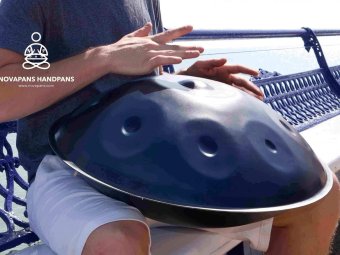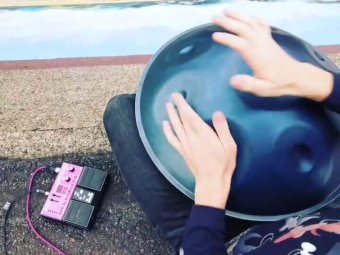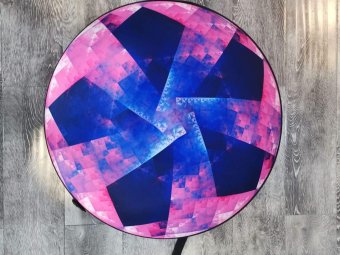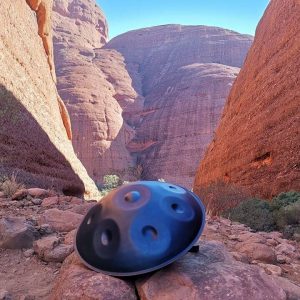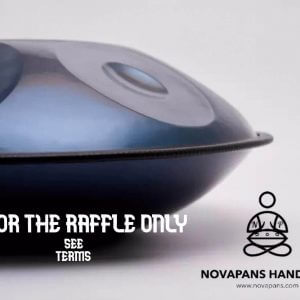Handpan Categories – Breaking it all down

When it comes to categorizing handpans there's a couple things (only a couple!) to help break it down. When you know what type of model, player, scale, key, frequency, aesthetic the handpan you want is or has, it can really help you understand how to find the handpan of your dreams without too much ducking and diving or guess-gaming. With these specifications, you can save yourself a lot of time and money by quickly and efficiently narrowing down your handpan search and selection. So, let's get to it!
- Handpan Model
The actual handpan model you choose will be determined by the metal type (nitrided steel or stainless steel are the main ones). Although nitrided metals were long the popular go-to option for all handpans and they have a reputation for really allowing their handpan to sing and project with controlled intonation (play loud without adversely affecting the note sound quality), the stainless steel handpans quickly developed a name for themselves because of their particularly exceptional sustain and meditation sound. With that said, if you are looking for a handpan model whose sound it big and boastful, choose a Nitrided Steel Handpan (our Generation 3s or 4s) - great for busking, playing solo, playing with other instruments or making instrumental videos and performances. If you are looking for a handpan model whose sound is mellow but long and immersing, choose a Stainless Steel Handpan (our Generation 7s) - great for meditation, sound healing, sound journeys or ceremonies, and calming.
- Handpan Player
It doesn't really matter who plays the handpan you purchase however what's useful is to know what the handpan you like sounds like when played by someone you admire. If you love the resonant and joyous sounds of the way Ethereal in E plays, then you might inclined to get a handpan which also sings and sounds just as open-heartedly and present/ecstatic (one of our Nitrided Models). At the same time, Ethereal in E also makes multi-hour meditation handpan tracks and videos where a Stainless Steel Model would serve you better. Therefore, the type of handpan player you like can definitely help you determine if you want either the Performance Handpans (Generation 3s and 4s) or the Sound Healing Handpans (Generation 7s).
- Handpan Scale
The choice of Handpan Scale is possibly much more important than you original thought it was because the handpan scale determines the mood! Some scales are major, while others are minor. You then get further enhanced versions of both Major and Minor scales (Augmented and Diminished respectively) which can further enhance this mood that your going for. Major's tend to have a connotation of elation or happiness perhaps, while Minor's tend to be more on the melancholy or suspenseful part of the spectrum. Here are some scales you may have noticed before and their mood descriptions which should help you get an idea of the kind of scale you want to go for. Definitely, always, listen to videos of these scales before making a final handpan choice decision and do not be simply swayed by words on a screen, or whispers from a tongue - as sometimes difficult as it can be to resist sometimes. You are your own person so make sure you choose what you want.
The Kurd: The Kurd scale stands out as the inaugural scale ever released on handpan, which likely contributes to its widespread popularity. Exploring the theory behind the scale, one can discern that it is the raised third note (for the technically inclined musicians out there :D) that elevates this scale from a simple minor scale to a harmonic and therefore more enigmatic minor scale. Due to these unique qualities, the Kurd scale is especially suitable for those seeking to evoke a sense of mystery or embark on an adventurous sonic journey, akin to what is experienced in the traditional handpan performances by Hang Massive and Daniel Waples (who also play on Kurd scales). As a matter of fact, D Kurd is the most prevalent scale and an optimal choice for beginners delving into the world of handpans.
The Amara: Presenting the new Amara or "Angel" scale! The Amara possesses a noticeably uplifting and flowing nature, especially when compared to the Kurd. If you seek a very serene, tranquil, and otherworldly musical experience, then the Amara scale is the ideal choice for you. It's uncomplicated, delightful to play, and its Major scale can effortlessly transport anyone with its gentle yet flowing sound.
The Pygmy: The Pygmy scale has a unique storytelling quality. While it may not have the enigmatic allure of the Kurd or the ethereal charm of the Amara, it certainly evokes its own majestic imagery of nature, reminiscent of a forest fairy tale. This scale could be seen as having deeper Celtic influences or allusions, perhaps.
The Sabye: The Sabye scale evokes a sense of nostalgia and the leisurely passage of time when it is played. Some people liken it to Japanese anime, while others associate it with their childhood, brimming with innocence and curiosity due to its unique sound.
The Hijaz: The Hijaz scale is truly intriguing! If you're a fan of mystery or suspense, the Hijaz scale might pique your interest. However, it's important to note that this scale is rather complex and not easy to master. Those familiar with it understand that the Hijaz is best suited for solo performances, carrying deep Egyptian and Arabesque influences. It's perfect for creating enigmatic and captivating musical narratives.
The Goonkali: The Goonkali handpan is a hit with experienced handpan enthusiasts who are looking for something as enigmatic as the Kurd but with an extra touch of "spice," so to speak. The additional higher notes, particularly with the wider note intervals between them, provide the Goonkali with a diverse range of notes, resulting in a more impactful storytelling effect. If you're interested in crafting a sonic journey or narrative with heightened drama and impact, the Goonkali might just be the ideal choice for you.
The Halcyon: The renowned influencer Ethereal in E favors the tranquil Halcyon scale, which complements the serene backdrop of the Ohio lake perfectly. Its calming and sedating qualities make it ideal for nature outings or extended sound journeys in natural settings.
The Pentatonic Major: The Pentatonic Major scale is a newer addition that combines elements of Amara and Sabye, evoking both ethereal and nostalgic storytelling. It's a delightful scale for crafting an ambient, tranquil, and relaxing atmosphere.
- Handpan Key
Just when you thought it couldn't get more complex! Well, it doesn't really have to (I know I'm reassuring). But really, once you've picked your scale and the model above, the only thing you have to worry about when choosing your handpan key is what your first note is going to be - and that's exactly all it is. When they say oh, it's a D Kurd, it simply means that your handpan is in a Kurd scale which starts on a D. If they say oh, it's an F# Hijaz, it again simply means it's a handpan in the Hijaz scale starting on F#. What note you choose actually determines how high or low-sounding your handpan is going to sound. Now bear in mind that not all handpans can physically reach the lower notes (such as F2 to C3 - the numbers indicate how high or low these notes are on scale whereby the lower the number, the lower the note. In fact, the lower the first note can be on a handpan, the bigger it is a sign of quality and control that that handpan has, which is typically the case with stainless steel handpans). Try to listen to different handpan keys (i.e. with different first notes) and see which starting note you like best. Most people have opted for the key of D3 which is interesting, since research seems to suggest that the key of D has connotations of integrity and seriousness. Meanwhile, Beethoven was known to prefer a key of F Minor which really is said to be more melancholic. Ultimately again, it's up to you! An F3 Handpan will sound a lot higher than a D3 Handpan or even an B2 Handpan! A lower-pitched handpan might feel more encompassing or embodying of a sound space, while a higher-pitched might sound more distinctive, potentially shrill (if not played gently). Have a listen and let us know what you like! Here are all the key tonalities we offer: F2, F#2, G2, G#2, A2, A#2, B2, C3, C#3, D3, D#3, E3, F3, F#3.
- Handpan Frequency
Almost there! With the world of sound and music you'll soon discover that everything is measured in terms of frequencies which can be broken down into mathematical relationships with one another (picture sine waves and how every wave technically is somewhat related). Notes themselves, or scales, are notes that are also defined by their frequencies. For example, the note A3 has been defined by most traditional musicians as having the frequency of 440hz. However, this "note of A3" is not the absolute A3. In fact, the absolute (or actual) A3 is not defined. For example, some people (especially in older cultures and practices) believe that the true A3 is the one that is tuned slightly lower by 8hz, in 432hz. What this means is that you've got a portion of the population who believe their notes should be tuned 8hz higher and another portion of the community who believe their handpans should be tuned 8hz lower. Although this means handpans or musical instruments which are tuned to 440hz and 432hz cannot really be played together without creating a cacophonous dissonance, it does beg the question of what really is the difference or benefits of either frequency? From the get-go, research will tell and show you that 432hz is regarded as the Miracle Frequency which, when you see that the frequency of nature and animals on the planet are also resonating at, you begin to pay some interest to also. Some people don't believe it. We do. As a team of classical musicians with years of music engrained into us, we definitely notice a difference of mood and overall calmness when playing in 432hz; it's a lot more soothing. Just bear in mind that since most other instruments are produced in 440hz that your 432hz will not necessarily harmonise with these. 432hz instruments definitely resonate with other 432hz instruments though!
- Handpan Aesthetic
This is a personal factor as the color or design of your handpan really is up to you. Just be aware that some coloring effects or designs can alter the sound of your handpan, not necessarily in a bad way. For instance, there are our coated Generation 7 handpans whose sound becomes slightly more dampened, a big like pressed the damper pedal on the piano. It's a whole new sound effect and again, it comes down to personal preference. Do NOT let anybody tell you that your handpan is not good enough because their sound opinion is different to yours.
If you have any other questions or concerns regarding your handpan journey be that purchasing or learning or simply dealing with other naysayers (because elitism still exists in a community that was once dominated and monopolized by only a handful of European makers), let us know. We are here!
All the best,
NovaPans Handpans
Discover our handpans
-
9 Note Handpans in Multiple Keys (Kurd, Amara) in 432hz or 440hz in Blue (Nitrided Steel) | Generation 3
$1,999.00 – $2,069.00 Select options This product has multiple variants. The options may be chosen on the product page -
Handpan Hard Cases
Original price was: $290.00.$199.00Current price is: $199.00. Select options This product has multiple variants. The options may be chosen on the product page
More post about handpans
